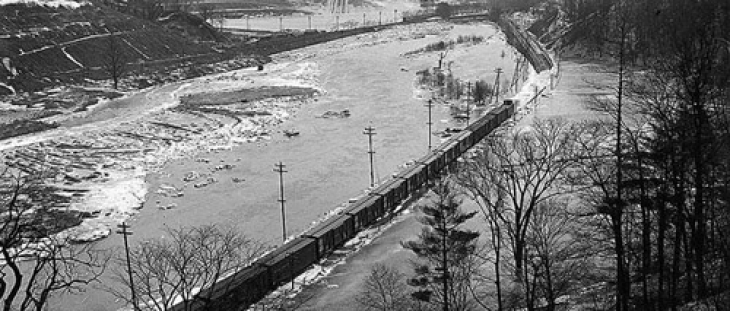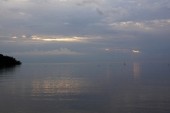
 A flooded Don River as seen from the Bloor Viaduct, 1918. (City of Toronto Archives) The Don River is part of who we are as Torontonians–whether we know it or like or not. With development of one sort or another in the cards for the Lower Don, along with its renaturalization, we decided to talk to Jennifer Bonnell, a University of Guelph environmental historian, about our ever evolving relationship with the river. Tonight, Bonnell will be giving a talk on “Imagined Futures for the Lower Don: A History of Big Ideas for a Small River” at the Riverdale library. Why should we care about the Don River? JENNIFER BONNELL: Our relationship with the river is a microcosm of our larger relationship with the natural world, and the planet as a whole. The river, like the planet, is a resilient system, but it has its limits. Over the last 200 years, we have seen our relationship with the river change, from early settler’s experiences of the river as a provider of water, lumber, clay, and fish (and, for Elizabeth Simcoe, of picturesque landscapes for her paintings), to late nineteenth-century experiences of the river as a polluted and disease-ridden periphery, to efforts in the 1960s and beyond to reclaim and restore the river as an important urban green space. In these later campaigns, the river became a symbol of urban health, and the health of our relationship with the environment upon which the city depends. Nature is everywhere in the city–in the water that flushes our toilets, in the grass that pushes through small cracks in the sidewalk, in the concrete, glass, and clay that shape our buildings. As cities look ahead to the future, the quality of our ground water aquifers, our air, and our microclimates will depend increasingly on the few green spaces we have left. Even a heavily urbanized watershed such as the Don plays a role in regulating the city’s ecological systems; protecting and bettering the ecological integrity of its remaining green spaces becomes in this context an important issue for the future of the city. What can the history of the Don River tells us about the history and development of the city as a whole? Until the annexation of Riverdale (then Riverside) in 1884, the Don River formed the eastern margin of the city. It was a place “at the edges” and thus became a sink for the city’s wastes–a place to put things best left unseen: noxious industries like tanneries, slaughter houses, and oil refineries; stock piles of flammable material like coal and lumber; sewage outfalls; and solid wastes (to date almost 150 unofficial dump sites have been found throughout the watershed). It was also a place that provided refuge to “social” undesirables: homeless transients, gangsters, Depression-era hobos, and during WWII, a labour camp for POWs. So the Don and its history provides a nice illustration of the social and environmental “costs” or externalities of city-building. River valleys like the Don which once played important roles as providers of raw materials, played an equally significant role as sinks for its wastes. ??The river valley’s role as a transportation corridor–for voyageurs in the 1700s, rail by the late 1800s, and an urban expressway by the 1960s–has also played a significant role in shaping the city. The construction of the DVP in the early 1960s facilitated rapid suburban development in the city’s north-east. Today, it is hard to imagine how the city would function without it. What’s something that people generally don’t know about the Don, but you think they should? Like the Cuyahoga River in Cleveland (subject of the famous Time magazine article in 1969 about the burning river as a symbol of environmental degradation), the Don also caught fire. Oil seepage from refineries near the mouth of the river presented an ongoing problem to businesses and industries in the area, who expressed their concerns about fire risk, and for boat builders and boat repair operations, about damage to ship hulls from floating slicks of oil, in a series of letters to the Toronto Harbour Commissioners in the 1910s and 20s. The river did eventually catch fire, not once but twice in February 1931, the second causing significant damage to a bridge crossing the river at Keating Street, but no loss of life. How do you think Doug Ford’s proposal for the Waterfront would have affected the area? We would have seen more of the same wall of condos that characterizes the central waterfront, with little concern for public access to the waterfront or open spaces for public enjoyment. Opportunities for the naturalization of the waterfront, however limited, would have likely been completely bypassed by Ford’s proposal. In short, we would have seen more of the same laissez-faire, “anything goes” development on the waterfront. Waterfront Toronto’s plans for the waterfront fit within a larger trend in many of the world’s great cities–Copenhagen, Hamburg, to name a few–to transform industrial portlands into residential communities and public destinations. Had we adopted Ford’s vision, we would have missed an opportunity to create a destination, to put Toronto on the map internationally as a city with a dynamic, publicly-accessible and creatively-designed waterfront. What do you think about Waterfront Toronto’s plan for the Lower Don? Is there anything you may have added or taken away from their proposal? I think it’s important to retain as much waterfront land in public hands as possible, so while I support Waterfront Toronto’s efforts to incorporate public space into their plans for the waterfront, it concerns me to see so much of these holdings sold to private developers in order to finance waterfront redevelopment initiatives. I think the Don Mouth Naturalization Plan represents a promising vision for the area. I’m especially interested to see some of the plans evolve over the coming years, it will be important to retain the high degree of public involvement that has characterized the planning process to date, in order to ensure that naturalization and public open space remain key features of the plan. Could you suggest a Don River walking tour? There are many great walks along the Don River. An easy beginning is to walk north along the Lower Don Recreational Trail from Riverdale Park to Pottery Road, and beyond to the Beechwood Wetland area. New trails in the Charles Sauriol Conservation Reserve and Milne Hollow (southeast corner of Lawrence Avenue and the DVP), along the East Don, also offer some great opportunities to experience nature in the city. Lost Rivers, an urban ecology organization, also conducts free walks in the Don and other Toronto-area watersheds. Imagined Futures for the Lower Don: A History of Big Ideas for a Small River happens at the Riverdale Public Library tonight from 7pm-8pm.
A flooded Don River as seen from the Bloor Viaduct, 1918. (City of Toronto Archives) The Don River is part of who we are as Torontonians–whether we know it or like or not. With development of one sort or another in the cards for the Lower Don, along with its renaturalization, we decided to talk to Jennifer Bonnell, a University of Guelph environmental historian, about our ever evolving relationship with the river. Tonight, Bonnell will be giving a talk on “Imagined Futures for the Lower Don: A History of Big Ideas for a Small River” at the Riverdale library. Why should we care about the Don River? JENNIFER BONNELL: Our relationship with the river is a microcosm of our larger relationship with the natural world, and the planet as a whole. The river, like the planet, is a resilient system, but it has its limits. Over the last 200 years, we have seen our relationship with the river change, from early settler’s experiences of the river as a provider of water, lumber, clay, and fish (and, for Elizabeth Simcoe, of picturesque landscapes for her paintings), to late nineteenth-century experiences of the river as a polluted and disease-ridden periphery, to efforts in the 1960s and beyond to reclaim and restore the river as an important urban green space. In these later campaigns, the river became a symbol of urban health, and the health of our relationship with the environment upon which the city depends. Nature is everywhere in the city–in the water that flushes our toilets, in the grass that pushes through small cracks in the sidewalk, in the concrete, glass, and clay that shape our buildings. As cities look ahead to the future, the quality of our ground water aquifers, our air, and our microclimates will depend increasingly on the few green spaces we have left. Even a heavily urbanized watershed such as the Don plays a role in regulating the city’s ecological systems; protecting and bettering the ecological integrity of its remaining green spaces becomes in this context an important issue for the future of the city. What can the history of the Don River tells us about the history and development of the city as a whole? Until the annexation of Riverdale (then Riverside) in 1884, the Don River formed the eastern margin of the city. It was a place “at the edges” and thus became a sink for the city’s wastes–a place to put things best left unseen: noxious industries like tanneries, slaughter houses, and oil refineries; stock piles of flammable material like coal and lumber; sewage outfalls; and solid wastes (to date almost 150 unofficial dump sites have been found throughout the watershed). It was also a place that provided refuge to “social” undesirables: homeless transients, gangsters, Depression-era hobos, and during WWII, a labour camp for POWs. So the Don and its history provides a nice illustration of the social and environmental “costs” or externalities of city-building. River valleys like the Don which once played important roles as providers of raw materials, played an equally significant role as sinks for its wastes. ??The river valley’s role as a transportation corridor–for voyageurs in the 1700s, rail by the late 1800s, and an urban expressway by the 1960s–has also played a significant role in shaping the city. The construction of the DVP in the early 1960s facilitated rapid suburban development in the city’s north-east. Today, it is hard to imagine how the city would function without it. What’s something that people generally don’t know about the Don, but you think they should? Like the Cuyahoga River in Cleveland (subject of the famous Time magazine article in 1969 about the burning river as a symbol of environmental degradation), the Don also caught fire. Oil seepage from refineries near the mouth of the river presented an ongoing problem to businesses and industries in the area, who expressed their concerns about fire risk, and for boat builders and boat repair operations, about damage to ship hulls from floating slicks of oil, in a series of letters to the Toronto Harbour Commissioners in the 1910s and 20s. The river did eventually catch fire, not once but twice in February 1931, the second causing significant damage to a bridge crossing the river at Keating Street, but no loss of life. How do you think Doug Ford’s proposal for the Waterfront would have affected the area? We would have seen more of the same wall of condos that characterizes the central waterfront, with little concern for public access to the waterfront or open spaces for public enjoyment. Opportunities for the naturalization of the waterfront, however limited, would have likely been completely bypassed by Ford’s proposal. In short, we would have seen more of the same laissez-faire, “anything goes” development on the waterfront. Waterfront Toronto’s plans for the waterfront fit within a larger trend in many of the world’s great cities–Copenhagen, Hamburg, to name a few–to transform industrial portlands into residential communities and public destinations. Had we adopted Ford’s vision, we would have missed an opportunity to create a destination, to put Toronto on the map internationally as a city with a dynamic, publicly-accessible and creatively-designed waterfront. What do you think about Waterfront Toronto’s plan for the Lower Don? Is there anything you may have added or taken away from their proposal? I think it’s important to retain as much waterfront land in public hands as possible, so while I support Waterfront Toronto’s efforts to incorporate public space into their plans for the waterfront, it concerns me to see so much of these holdings sold to private developers in order to finance waterfront redevelopment initiatives. I think the Don Mouth Naturalization Plan represents a promising vision for the area. I’m especially interested to see some of the plans evolve over the coming years, it will be important to retain the high degree of public involvement that has characterized the planning process to date, in order to ensure that naturalization and public open space remain key features of the plan. Could you suggest a Don River walking tour? There are many great walks along the Don River. An easy beginning is to walk north along the Lower Don Recreational Trail from Riverdale Park to Pottery Road, and beyond to the Beechwood Wetland area. New trails in the Charles Sauriol Conservation Reserve and Milne Hollow (southeast corner of Lawrence Avenue and the DVP), along the East Don, also offer some great opportunities to experience nature in the city. Lost Rivers, an urban ecology organization, also conducts free walks in the Don and other Toronto-area watersheds. Imagined Futures for the Lower Don: A History of Big Ideas for a Small River happens at the Riverdale Public Library tonight from 7pm-8pm.














